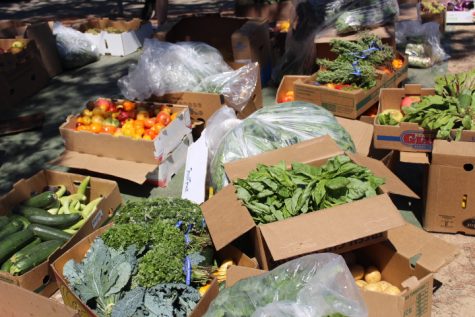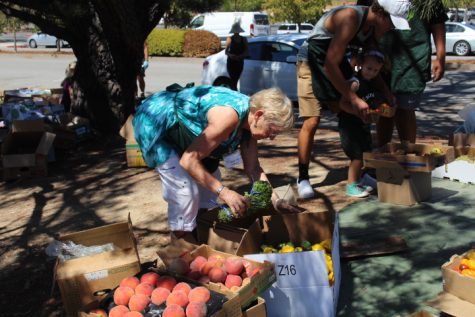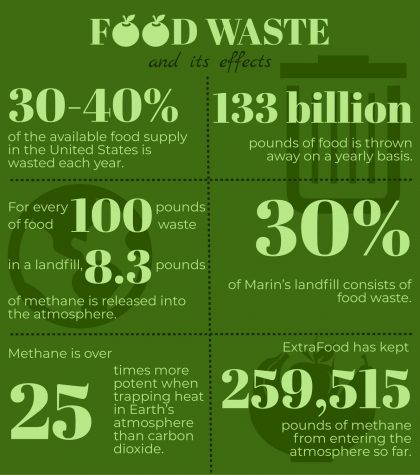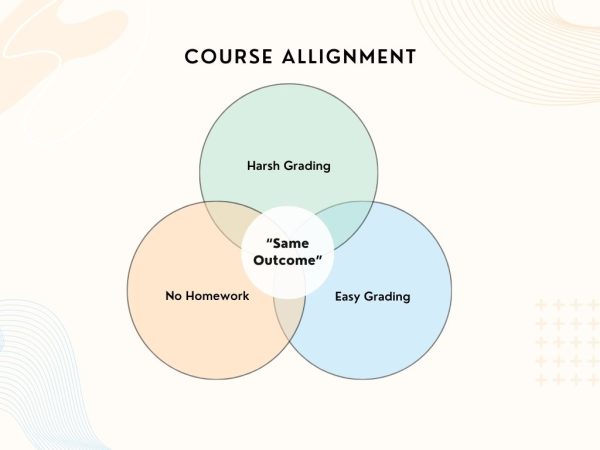Wasting away: Marin organizations strive to solve the issue of excess food
September 16, 2019

From the imperfect produce in farm fields to kitchen scraps at home to half-eaten school lunches, tons of usable food is tossed away globally at the expense of the environment. The United States wastes about 30 to 40 percent of the available food supply each year, according to the United States Department of Agriculture, which defines food waste as reductions in any edible food during the food production process. This means about 133 billion pounds of food is thrown away on a yearly basis.
Through depleting our resources and harming the atmosphere, food waste has become an ever-expanding global issue. Because of this, organizations and students throughout Marin are working to minimize the production of excess food.
ExtraFood is one of these entities. The nonprofit organization takes food that would otherwise be thrown away from a range of businesses around Marin and donates it to people who are in need of meals. Kathy Carver, the manager of food donor and recipient relations for ExtraFood, has worked closely with farmers and in sustainable agriculture in the past, inspiring her care for issue of food waste.
“We should all be concerned about [wasting food] because we’re throwing away tons of food in the landfill, which is an absolute global environmental disaster. It’s not just the United States. Everywhere there’s a huge amount of food waste,” Carver said.
According to the Marin Sanitary Service, approximately 30 percent of Marin’s landfill consists of food waste. For every 100 pounds of food waste in a landfill, 8.3 pounds of methane is released into the atmosphere, resulting in a significant negative impact on the environment. According to the United States Environmental Protection Agency, methane is over 25 times more potent when trapping heat in Earth’s atmosphere than carbon dioxide is and consequently contributes significantly to global warming. According to Carver, ExtraFood has collected and redistributed almost three million pounds of excess food, significantly helping in reducing methane emissions.

“That food has been delivered to 121 different nonprofit recipient partner sites all over the country. So we’ve delivered to 121 different nonprofits and we’ve kept 237,105 pounds of methane from warming the planet,” Carver said. Since the interview, the amount of methane kept from the atmosphere due to ExtraFood’s deliveries has increased to 259,515 pounds.
The food donated to ExtraFood is taken from businesses throughout the production chain, from farm to table. According to Carver, food waste is extensive and can therefore be collected from virtually any place that grows, processes or distributes food. It is especially prevalent at the beginning of the production chain: farms.
“A lot of waste is left in the fields. There are very high and exacting standards on produce and what we buy in the store. Everyone wants the perfect apple or the perfect tomato: no bruises, no bumps, it has to be just the right size. So there’s a lot of produce that is thrown away because it doesn’t fit consumers’ expectations and the sort of requirements grocery stores have,” Carver said.
Rodriguez Farms, a local berry farm, strives to minimize their overall food waste by donating their excess produce to ExtraFood. Otherwise, the produce is given to their chickens or composted. Jose Carpio, a salesperson for the farm, attends several farmers’ markets each week to sell a wide variety of fruits and vegetables.
“Usually we do quality control from the field, so whatever is not fit for sale we put in the middle row, and we destroy it to prevent any pests to develop. Whenever we come to the market, we sort and pick out whatever is not good, and we save it for someone who is willing to put in the work, and they use it for juices, smoothies, jams. We sell it at a discount, so it doesn’t go to waste,” Carpio said.
According to Carver, grocery stores are another substantial source of food waste due to date labels which manufacturers place on products to inform consumers of the estimated time frame for which the food is at its freshest quality.
“Date labeling is very confusing. There’s no standard to it. It’s not federally regulated, so you see a lot of ‘best buy, sell by, use by, expires on,’ and everyone is very confused by these date labels, so stores have to take products off their shelves when they reach a certain date, and then they can’t sell them anymore, and all that goes to waste,” Carver said.
A significant portion of food waste also comes from the restaurant industry. Mark Nicandri, the Senior Vice President of Operations for Gott’s Roadside, is working to ensure as little food is wasted as possible at the restaurant. Portion sizes are regulated when dishes are made in the kitchen, and Gott’s Roadside provides containers to carry food home to encourage customers to not throw away their leftovers.
The restaurant has also developed systems to prevent food from being thrown away before the dishes are prepared, such as software programs to allow Gott’s to estimate the amount of food they will need. These enable them to order as closely to the necessary amount of food needed as possible and decrease the chances of having unused excess food in the first place. However, unexpected events such as machine failure can result in large quantities of unanticipated leftover food, in which case Gott’s Roadside either donates the excess to ExtraFood or calls their other restaurants for assistance.
“We have six other locations in the Bay Area, and if we bought too many hamburgers, we’ll call to one of the other restaurants and see if they need any burgers and take a safety in numbers approach where we’ll try to move it around. Throwing it away would be the last case scenario,” Nicandri said.
Despite efforts, keeping food out of the landfill continues to be an issue in America today, including at Redwood. Joe Stewart, AP Environmental Science and Sustainable Agriculture teacher as well as the advisor of Redwood’s Environmental Action Club, is encouraging composting as an alternative to throwing food away.
“I think that most people would agree that it makes a lot of sense on many levels to compost. It makes sense for the environment. It makes sense economically because it saves money on many levels. It’s a way to give back to the planet. Basically, if we compost stuff, we’re producing something that will allow us to grow more food in the future,” Stewart said.
When food is composted, it prevents the release of methane as the organic matter decomposes.
“Unfortunately, there’s a tradition of not composting. This means that all the systems that are in place, like the administrative systems and so forth on campus, they’re not used to [composting]. So there’s going to be some hesitancy on the part of administrators to change things,” Stewart said. “Likewise, on the part of the student body, there’s not necessarily knowledge about how to compost or there’s maybe a lack of caring because they don’t know about composting.”
The Environmental Action Club works to educate students while encouraging administrators to administer changes to the food waste systems currently implemented at Redwood.
Food waste is a global issue, but it can be solved, starting in your kitchen.
“It’s difficult to predict how much food people will eat, so often times there is waste. And then of course there’s waste even in our own homes because we over buy. We push food towards the back of the refrigerator. We forget about it,” Carver said.
However, with methods from composting to reducing tendencies to over buy to educating people, food waste and its resulting environmental impact can be significantly decreased.






















